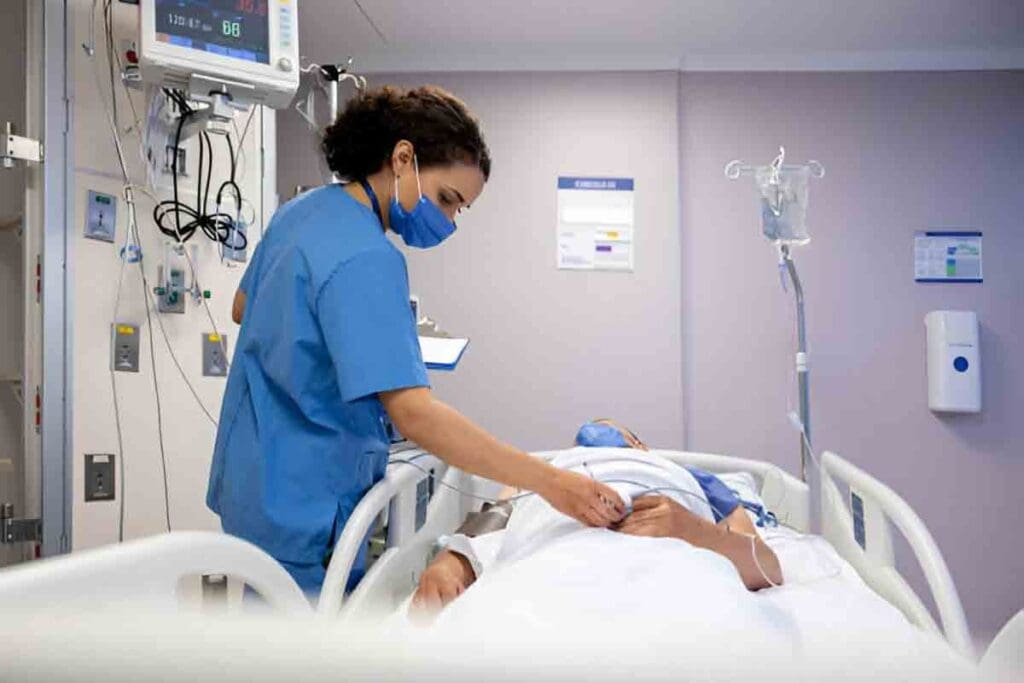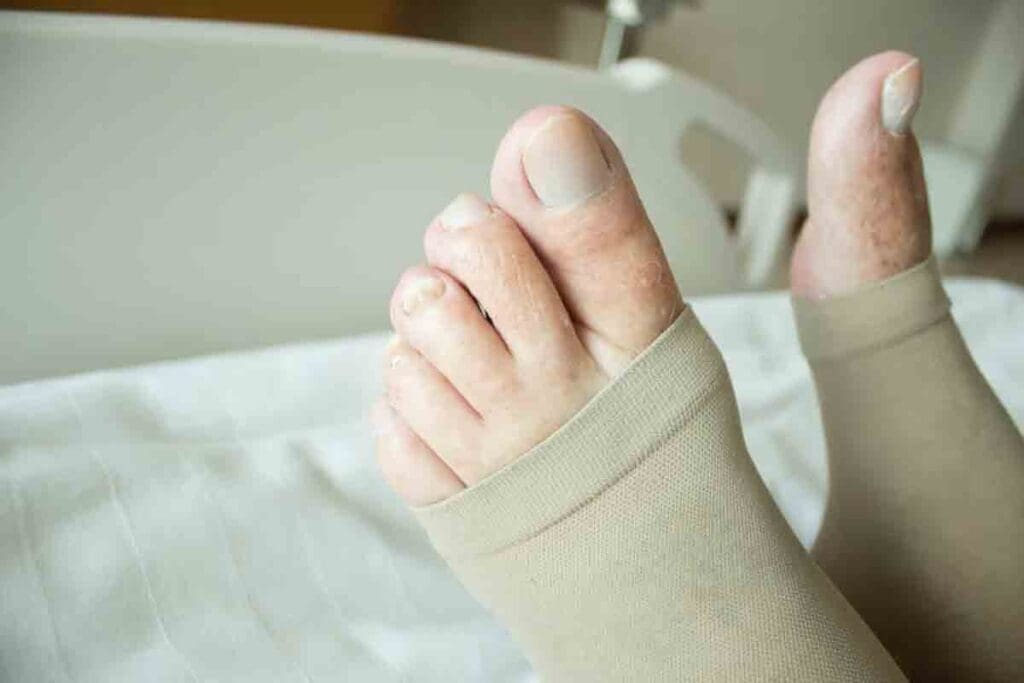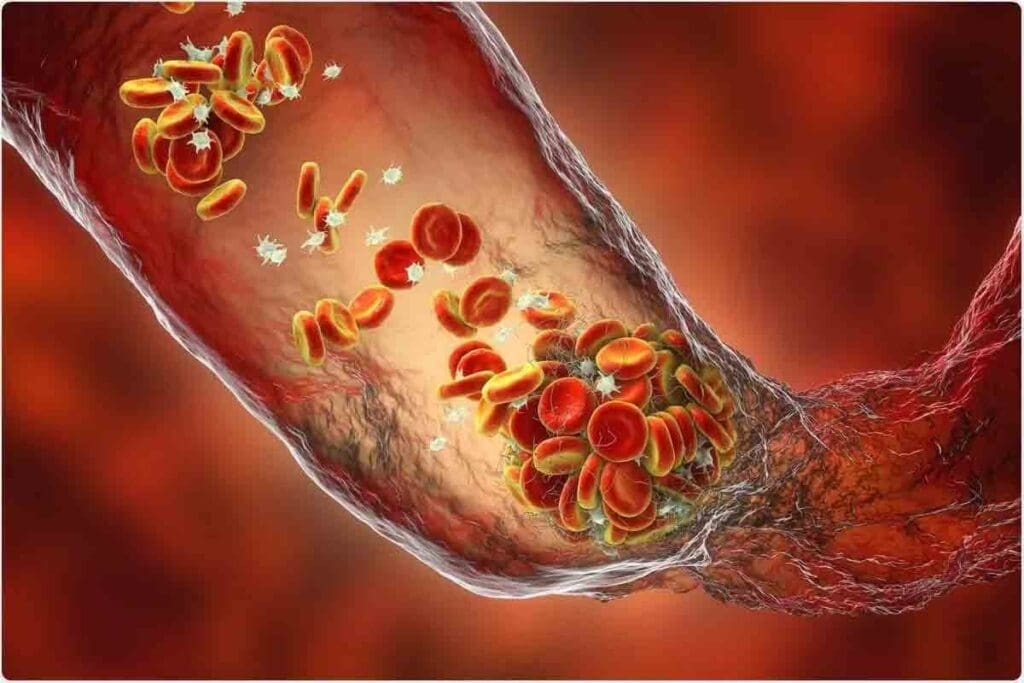Last Updated on November 17, 2025 by Ugurkan Demir

Deep vein thrombosis (DVT) is a serious condition where a blood clot forms in a deep vein. This usually happens in the calf, thigh, or lower leg. We want to help you understand the risks of DVT and how to spot its signs.
It’s a significant health concern, affecting up to 900,000 Americans each year. If not treated quickly, it can be life-threatening. At LivHospital, we stress the need to recognize a blood clot in your leg early.
Knowing the symptoms of DVT is key to your health and safety. We offer detailed care and advice to help you deal with DVT diagnosis and treatment.

Deep vein thrombosis (DVT) is a serious condition where a blood clot forms in a deep vein, usually in the legs. It can cause severe health problems if not treated quickly.
DVT happens when a blood clot forms in the deep veins. Several things can make you more likely to get DVT, like:
These factors can damage blood vessel walls or change how blood clots, leading to a blood clot.
Blood clots from DVT often form in the:
These areas are more likely to get clots because blood pools there, mainly when standing or sitting for a long time.
DVT is a serious condition because it can cause severe problems, like:
Quickly finding and treating DVT is key to avoiding these serious issues and getting the best care for patients.

It’s vital to know the signs of Deep Vein Thrombosis (DVT) to get help quickly. DVT happens when a blood clot forms in a deep vein, usually in the legs. Spotting the symptoms early can prevent serious problems.
DVT symptoms can show up in different ways, making it hard to spot. You might see swelling, pain, tenderness, warmth, and red or bluish skin. These signs often appear in one leg. We’ll explain how these symptoms usually show up to help you spot DVT.
Common Symptom Patterns:
DVT symptoms can differ a lot from person to person. Some might have very bad symptoms, while others might not notice anything. Your age, health, and where the clot is can affect how bad the symptoms are.
“The clinical presentation of DVT can be highly variable, ranging from asymptomatic to severe symptoms.” –
American Heart Association
| Symptom | Variability |
| Swelling | Mild to severe |
| Pain | Absent to severe |
| Warmth/Redness | Variable |
Some DVT cases don’t show symptoms, known as “silent DVT.” This is very dangerous because it might not be caught until it’s too late. Knowing the risk factors and getting checked if needed is very important.
We stress the need to know the DVT signs and that symptoms can change. If you think you or someone else might have DVT, getting medical help right away is key.
Swelling in one leg can be a warning sign of DVT, a blood clot. This swelling happens because the clot blocks blood flow. It leads to fluid building up in the leg.
DVT-related swelling comes from blocked blood flow in the deep veins of the leg. A clot can block blood flow, causing it to back up and leak into tissues. This leads to swelling, pain, and warmth in the affected area.
This swelling usually happens in just one leg. Swelling in both legs is more likely due to heart or kidney problems.
To spot swelling from DVT, measure and compare both legs. Here’s how:
Remember, swelling is a key sign, but not the only one. Look for pain, tenderness, and skin color changes too. These signs help figure out if you might have DVT.
Pain and tenderness in the leg are key signs of DVT. This discomfort can show up in different ways. It’s important to know what to look for to spot DVT early.
DVT pain usually happens in the calf or the back of the thigh. It feels like a cramp or a pulled muscle that doesn’t get better with rest. This pain can keep coming back and get worse if not treated.
Common areas affected by DVT pain include:
It’s important to tell DVT pain from other leg pain. DVT pain often comes with swelling, redness, or warmth in the leg. It doesn’t go away with rest or over-the-counter pain meds.
“The pain of DVT is often more severe and persistent than typical muscle soreness, and it’s usually accompanied by other signs like swelling or redness.” – Vascular Surgeon
A blood clot in the thigh can cause pain that feels like a deep ache or heaviness. This pain gets worse with movement or pressure. The pain’s intensity can change, and it might be swollen or tender.
| Symptom | DVT Characteristics | Other Leg Pain Characteristics |
| Pain Location | Typically in the calf or back of the thigh | Can vary widely depending on the cause |
| Pain Description | Cramp-like or feeling like a pulled muscle | Can be sharp, dull, aching, or burning |
| Associated Symptoms | Swelling, redness, warmth | May or may not have associated symptoms |
Knowing how DVT pain acts is key for early treatment. If you have ongoing leg pain or tenderness, and it’s swollen or red, see a doctor right away.
Skin discoloration and warmth are signs of a blood clot. A Deep Vein Thrombosis (DVT) causes inflammation in the leg. This leads to changes in skin appearance and temperature.
A blood clot in the leg makes the skin red or discolored. The affected area may become swollen and tender to the touch. Sometimes, the skin turns bluish, known as cyanosis, because of the blocked vein.
As a medical expert says, “The presence of a blood clot can cause the skin to become warm or even hot to the touch. This is due to the body’s inflammatory response to the clot.”
The skin over the clot may feel warm or even hot. This warmth is a result of the body’s natural response to the clot, which involves increased blood flow to the area. It’s important to compare the temperature of the affected leg with the other leg to notice any differences.
DVT appearance can vary significantly from one person to another. While some individuals may exhibit pronounced skin discoloration and warmth, others might not display any visible symptoms at all. Being aware of these variations is key to identifying DVT.
A vascular specialist notes, “The signs of DVT can be subtle. In some cases, there may be no symptoms until the clot has grown significantly or broken loose.”
Identifying DVT symptoms by location is key. We’ll look at signs in the calf, lower leg, upper leg, and foot. This will help you understand DVT better.
DVT in the calf might feel tight or painful when walking or standing. An expert says,
“Calf DVT can cause pain or discomfort in the back of the lower leg, which may worsen when standing or walking.”
Being aware of these signs is important. They could mean you have a blood clot.
DVT in the lower leg shows as swelling, redness, and warmth. You might also feel pain or tenderness. These signs mean you should get checked for a blood clot. Early detection is key to avoid serious problems.
A blood clot in the upper leg can cause thigh pain or swelling. The pain might feel dull or sharp. It’s important to watch for these signs, as upper leg DVT is dangerous.
A swollen foot could mean DVT, with pain or color changes. Look out for these signs. Prompt medical attention is needed if they don’t go away or get worse.
In summary, knowing DVT symptoms by location is critical. By recognizing signs in different leg areas, we can protect our vascular health.
Certain symptoms can show if you have a blood clot in your leg. Deep Vein Thrombosis (DVT) can cause different feelings that you should notice. It’s important to know what to look for.
Yes, some people with DVT feel symptoms. They might feel their leg is heavy or tight. Others say it feels tight or firm in a strange way.
These feelings can be different for everyone. They might not always show up as visible signs.
A sign of DVT is hard or firm spots in the leg. This happens because of the clot in the deep veins. It makes the area feel hard.
If you notice any unusual firmness, see a doctor. It’s important to check it out.
DVT can also make veins look and feel different. The vein might look bigger or feel like a cord. These changes can be a big sign of DVT.
They are more important if you also have swelling or pain. If you see these changes, get medical help right away.
In summary, knowing about DVT’s physical signs can help catch it early. Watch for any unusual feelings or changes in your legs. If you’re worried, talk to a healthcare professional.
After surgery, the risk of Deep Vein Thrombosis (DVT) goes up. This is a serious condition that needs quick medical help. It’s key to watch for DVT signs, mainly after surgery, to catch it early.
DVT can happen after surgery because of being stuck in one place for too long. It can also come from vein damage or other surgery-related issues. Look out for swelling, pain, and tenderness in the leg.
It’s important to tell the difference between these symptoms and normal post-surgery pain. Big swelling, severe pain that doesn’t go away, and tenderness are warning signs. They mean you should see a doctor right away.
Being careful about new or getting worse symptoms is key to spotting a blood clot after surgery. Watch for swelling, pain when moving, or skin color changes. Checking the leg for warmth, tenderness, or firmness regularly can help find clots early.
Getting worse symptoms can mean a blood clot is growing. If pain gets stronger, swelling gets bigger, or skin color changes, it’s a sign. Keeping an eye on how symptoms get worse is very important.
Tell your healthcare team about any changes. Quick action can stop serious problems.
If you’re feeling symptoms of Deep Vein Thrombosis, it’s important to know when to get help. We’ve listed 11 key signs, like swelling and pain in one leg. These signs are important because DVT can get worse if not treated.
If you think you might have DVT, get medical help right away. Waiting too long can lead to serious problems, like pulmonary embolism. If you notice any of these symptoms, see a doctor. They can check you and start treatment to avoid more issues.
Getting medical help for suspected DVT is a smart move for your health. Knowing the signs and acting fast can help avoid serious problems. This way, you can get the best care and stay healthy.
Deep Vein Thrombosis is when a blood clot forms in deep veins, usually in the legs. It’s a serious issue that needs quick medical care. If not treated, it can lead to serious problems.
Blood clots in DVT often form in the deep veins of the legs. This includes the calf, lower leg, thigh, and upper leg. They can also form in other areas, but the legs are most common.
Look out for swelling in one leg and pain or tenderness. Skin discoloration and warmth are also signs. Calf pain, lower leg swelling, and upper leg discomfort are other symptoms.
Also, watch for a swollen foot. Hard or firm areas in the leg and visible vein changes can indicate DVT.
Yes, DVT can happen without obvious signs, known as “silent DVT.” People might not notice the usual symptoms. It’s important to know the risk factors and seek medical help if you suspect DVT.
Use a tape measure to compare leg sizes. Measure around the widest part of the calf or thigh. A big difference could mean swelling from DVT.
A blood clot might make the skin look red or blue. It might also feel warm. Not all DVTs show visible signs, so watch for other symptoms too.
Yes, you might feel DVT through tenderness, pain, or a hard area in the leg. You might also notice vein changes. But not feeling these symptoms doesn’t mean you don’t have DVT.
After surgery, look for swelling, pain, or tenderness in the leg. Skin discoloration and warmth are also signs. Watch closely, as the risk of DVT is higher in the first few weeks.
Blood clots in the legs are very serious. They can break loose and go to the lungs, causing a pulmonary embolism. This is a life-threatening condition. Seek medical help right away if you think you have DVT.
If you think you have DVT, get medical help right away. Don’t wait, as early treatment can prevent serious problems.
Subscribe to our e-newsletter to stay informed about the latest innovations in the world of health and exclusive offers!